More than 46 hours later, the credits are rolling on Bloodborne. I’m breathing a sigh of relief. The hunt may be over, but I won’t soon forget the city of Yharnam.
Bloodborne is a tremendous accomplishment. The latest game from Dark Souls director Hidetaki Miyazaki and his team at From Software, it is both a surprising refinement and reinvention of the Souls formula. Even though I’ve “beaten” the game, I want to jump into New Game Plus and keep slicing up monsters.
Bloodborne is a third-person action role-playing game for the PlayStation 4. In it, you play a man or a woman who picks up a variety of sharp and deadly weapons and fights all manner of horrific beasts, gradually growing more powerful while exploring a sprawling city and gradually uncovering its mysteries. The game takes place in Yharnam, a once-great and proud city known for its discovery of the art of “blood healing.” A sickness has taken root, however, and it’s turning the citizens into horrendous beasts. Your character is sick, too, and desires what medicines Yharnam has to offer. So, at the start of the game, you decide to partake of the blood and join the hunt, a regular event in which the bravest of Yharnam set out into the night and slay their transformed friends and family.
Let’s start by acknowledging that From’s games have a certain reputation. Yes, Bloodborne is hard. No, it won’t hold your hand. But the mystique of the Souls games is overblown. You can play them. I believe in you. I used to think they weren’t for me. “Oh, these games were for my teenage self, back when I endless free-time in the summer and winter, not an adult with limited time and less nimble fingers.” That’s not true at all, and don’t let the rhetoric surrounding Bloodborne throw you off. You don’t need to have played Dark Souls to enjoy Bloodborne, and you don’t need to be an expert gamer to have a good time.
Players are given access to an assortment of swords, hammers, and other dangerous objects, and there are key differences between each weapon. Each can transform in some way: the saw cleaver extends but takes longer to strike, the rifle spear doubles as a gun, the “kirkhammer” swaps a sword for a block of stone, and so on. You can transform your weapon mid-combo, leading to some dynamic, unpredictable attacks. It’s immensely satisfying to stab a werewolf with a sword, disabling him for a moment, then swap to a hammer mid-swing, stomping his head into gooey bits.
Demon’s Souls, Dark Souls, and Dark Souls II were sword-and-shield experiences, at least for me. I bumbled around in humorously bulky armour, absorbing whatever enemies could throw at me. It only took me a few minutes with Bloodborne to realise it had been designed to specifically prevent me from playing that way.
There are no shields in Bloodborne. Technically, the game makes one wooden shield available to you a few hours into the game, but the item’s description really says it all:
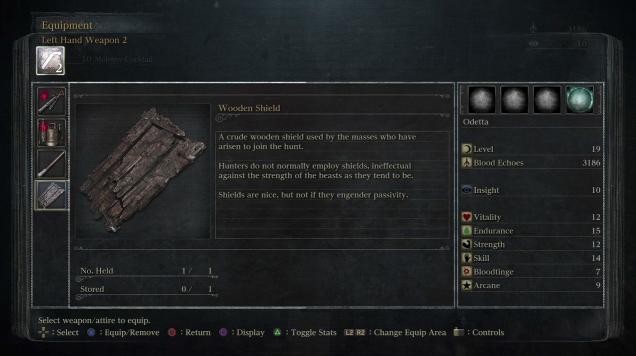
“Shields are nice, but not if they engender passivity.”
Bloodborne wants you to be aggressive, and it’s built several systems to accommodate this change in style. When an enemy hits you, you have a brief window to gain that health back. This is a huge change. Previously, one might be tempted to run away and cautiously heal after an enemy launches a powerful assault, but in Bloodborne, you’re likely to be better served by immediately hitting back. “Retreat and heal” is a tough habit to break, but the game, in typical Souls fashion, punishes you for not complying. Once you get used to staying uncomfortably close to enemies, taking your licks, and licking back, it’s a whole new world. A really fast world.
Your character’s movement changes based on whether you’re locked onto an enemy. Most of the time, the circle button performs an evasive roll, but when you’re locked onto an enemy, it becomes a speedy dash. Thanks to that, it’s now possible to pull off some stylish (and useful) dodges that will also keep you out of reach.
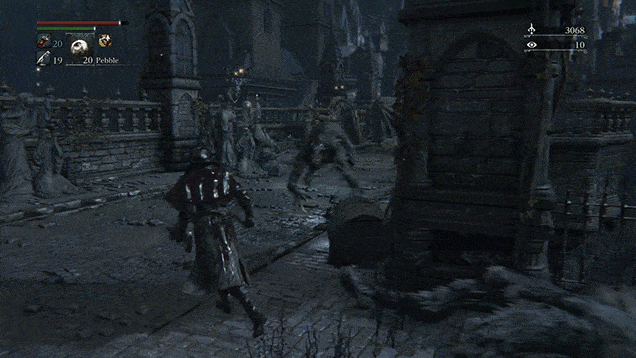
Bloodborne‘s all about avoidance, about taking advantage of an enemy’s arrogance to punish them for overcommitting. This is true when it comes to both dodging and to parrying. A well-timed dash can elegantly move you from the edge of a creature’s blade to safely behind their back, ready to crush them with a charged attack. While parrying — using careful timing to deflect an incoming blow — was a rewarding but optional part of combat in the other Souls games, it’s an essential tactic in Bloodborne. It’s a prize for waiting until the last second before an enemy strikes, popping them in the face with your gun, and gutting them.
I don’t play games to feel proud, but when I think about my favourite moments in Bloodborne, my heart skips a beat and I have to catch my breath, At one point, I spent hours banging my head against one of Bloodborne‘s later boss encounters, in which you’re asked to juggle three fast-moving enemies simultaneously. It’s rough.
It was late at night, my wife was asleep, and I’d come close to giving up and going to bed.
Then, it all came together — the perfect fight. I dodged at the right time to avoid a fatal blow, I attacked at the right time to land my own. The enemies disappeared. I’d won.
With no one else to brag to, I sent this message to my Kotaku colleague Kirk Hamilton:
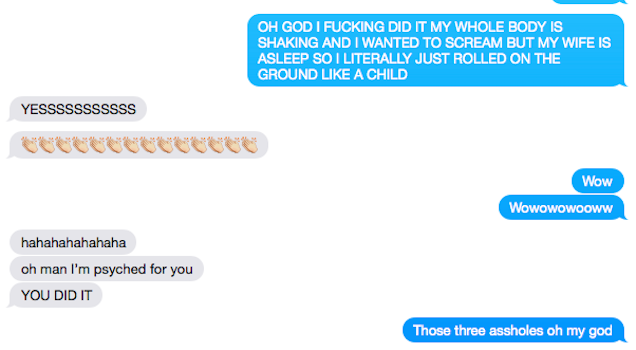
A night or two later, here’s what Kirk told me after finally vanquishing a different boss:

Just looking at those text messages makes me smile. Not many games are like this.
These are the reactions Bloodborne elicits from its devoted, patient players. Layers of skill, earned through hours of frustration, are rewarded with an explosion of joy. When Bloodborne clicks, it takes over — it’s a game that quietly seeps into every corner of your psyche. When you’re not playing Bloodborne, you’re thinking about it, or even (true story) dreaming about it. For a time, Bloodborne was life, and life was Bloodborne. Addicted is the wrong word. I was enthralled.
You may spend most of the game fighting for your life, but there’s a story here, too. Mostly, you’ll discover heartbreaking vignettes about the lost residents of Yharnam. Knock on a window and you’ll find a little girl hopelessly looking for her mother. You eventually find her mum, but she’s met with a tragic end. Another character barely hangs onto life, and even provides you with several useful items! Towards the end, he’s unable to keep going. Not to get all BuzzFeed on you, but what happened next, well, it made me pause the game for a moment. Your victories in Bloodborne are tremendous, but you’re surrounded by sadness.
The storytelling in Souls games can range from straightforward (Demon’s Souls) to incredibly vague (Dark Souls II), and Bloodborne falls somewhere in between. I’d developed a cloudy idea of the story’s big-picture events by the end, but I’m not sure I could fully put it into words, and it’s still not clear to me why my character was killing so many things, rather than out looking for a cure. (You know, ostensibly the reason you came to Yharnam in the first place.) Still, while the lore is interesting, it’s not what I’m here for. The important story isn’t found in any text or dialogue, it’s my understanding of how to play Bloodborne. It’s finding a new lantern in a dangerous area, just as I’ve run out of blood vials. It’s effortlessly downing a difficult boss after he’s spent the last hour tearing you from the inside out. Those are the stories you tell your friends, and that’s what sticks with you in the days after.
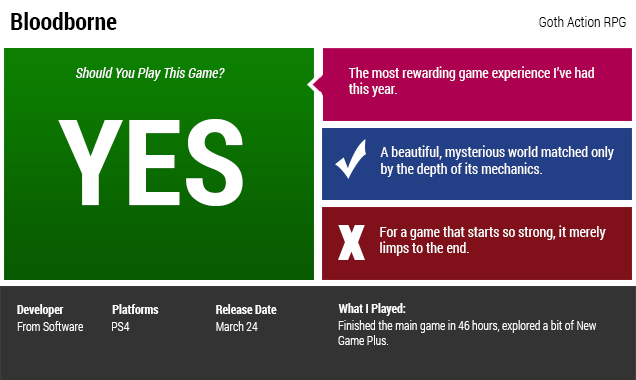
Bloodborne is a remarkably mysterious game. The fundamentals are explained well, but everything else? Good luck. That’s part of the charm — you’re meant to poke, prod, and share theories with fellow players. Yharnam can’t be “solved” alone, and the game encourages collaboration with fellow hunters in several ways.
Early in the game, you’re given a notebook that allows you to place hints and tips about the world using a set of words and phrases. If you’re connected to the Internet, tips from other players will populate your version of Yharnam. You can only create notes from a set of preordained words and sentence structures, but players get pretty clever within their restraints:
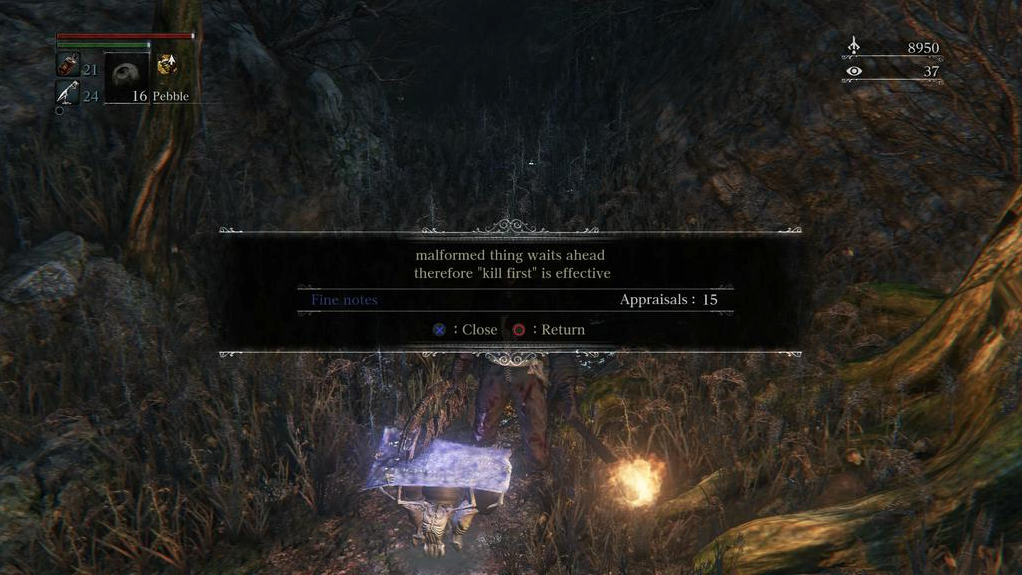
“malformed thing waits ahead / therefore “kill first” is effective”
The level designers behind Bloodborne are often tricking you with misdirection, and the notebook allows players to participate, as well. You can’t come across a hole in Bloodborne without one note suggesting you jump in to find treasure and another one warning of a liar. You’re allowed to give a thumbs up or thumbs down to notes, as well, and players will often approve notes designed to lead towards peril. When that happens, you can’t help but laugh.
It’s not always about misdirection, though. The beasts you face on a regular basis in Bloodborne are monstrous and unsettling, but their design serves multiple purposes, and the game’s art is often trying to subtly communicate with the player. Take the game’s first boss, Cleric Beast.
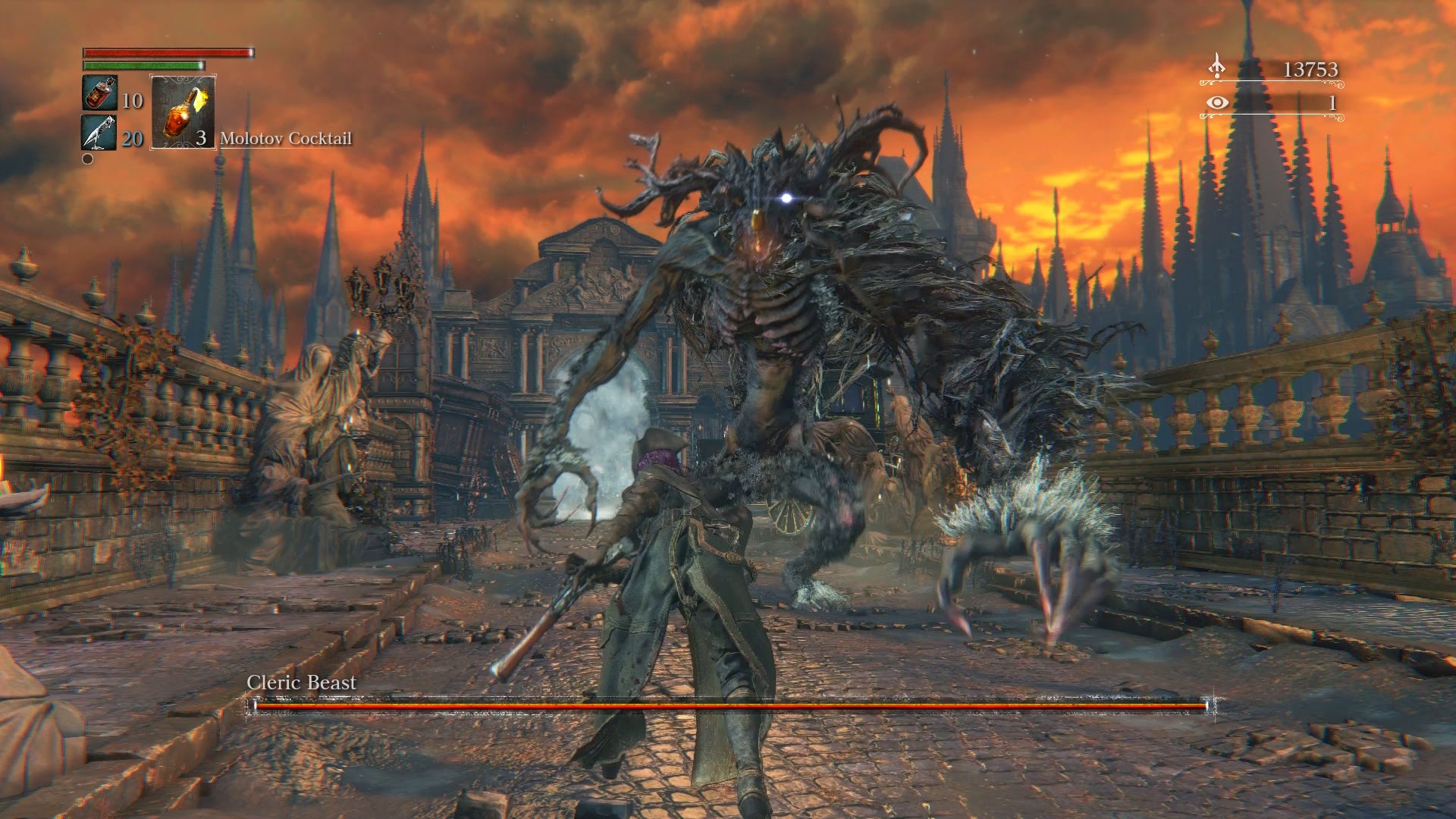
The first takeaway: holy crap. The second takeaway: how the heck am I going to kill this thing?
Let’s watch the Cleric Beast in action for a second, though.
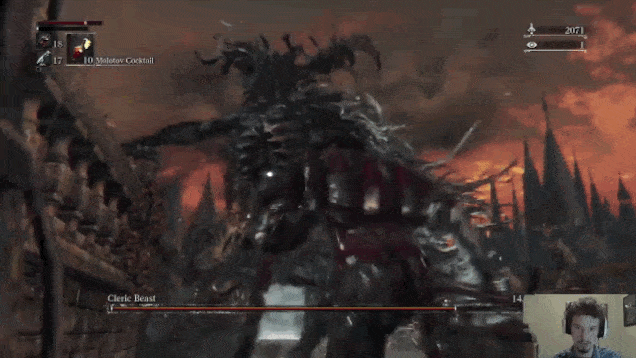
It’s a little tough to notice in this GIF, but his skinnier left hand isn’t able to sweep the whole area, while his bigger right hand can. If you watch the Cleric Beast for a little while, it’s clear he’s actually favouring the right hand.
This is the game trying to teach the player both through art and design.
With some patience and careful observation, which is understandably difficult to pull off in a stressful situation like a boss fight, Cleric Beast becomes very easy to kill. How? Just roll to the left, and he’ll rarely be able to hit you. You’ll go right under his arm.
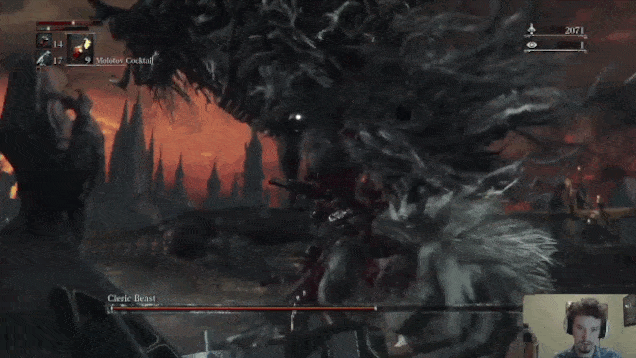
Bloodborne does this all the time. The game’s individual pieces — combat, art, design — work in concert to have a conversation with the player. You only need to listen.
There are surprises around every corner, and sometimes those surprises show up in areas you’ve already committed to memory. This is how the game keeps you on your toes.
Bloodborne isn’t a multiplayer game in the traditional sense — there’s no separate mode — but other players impact your game all the time. Ghost-like apparitions float in and out of your world, fleeting glances at what’s happening around you. Blood stains trigger replays of how other hunters died. Seeing another hunter alive and well is a small, but welcome, comfort. If they can do it, so can you.
Besides the notebook, you can temporarily “summon” others to tackle challenging areas together. The moment a boss is vanquished, they disappear. When you bring someone in, though, it means a player with ulterior motives can “invade” your world and kill you. Since you cannot know the intentions of other players, it’s a roll of the dice. It’s less risky than these games used to make it, so consider yourself lucky. In the past, it was possible for players to invade far more often. I sorta miss that, actually, but I might be alone there.
Underneath all of Bloodborne‘s chicanery and misdirection is the sense that the game rewards curiosity. As you play, your character will gain a higher and higher amount of something called “Insight.” This is what the game’s description for insight says:
“The Insight stat represents the depth of inhuman knowledge. Needed to ring special bell, but induces frenzy.”
At first, that will make no sense at all. Eventually, you’ll get a few different bells, and will learn that you can spend Insight points to ring the bells, which invite players to come join you in your game. Simple enough.
You gain insight from beating bosses and encountering new enemies in the first few hours, and you can also quickly cash it in for unique and powerful items. What I didn’t know until more than two dozen hours into the game, however, was that Insight was quietly changing the game’s difficulty. The more Insight I carried, the more powerful some enemy types became:
“Oh, this explains why I keep getting my arse kicked.”
The game never explains any of that, it leaves it to you to figure it out. Or, for another example: There’s a point where a new enemy shows up in familiar areas. Bloodborne knows the player is starting to feel cocky, having established a sense of control. This enemy can kill you with a single attack, and he probably will — that’s the point. And when he kills you, something entirely unexpected happens.
That sort of unforeseen moment, a mixture of fear and delight, is commonplace in Bloodborne. The game enjoys pulling the rug out from under you the moment you get comfortable, resulting in head-scratching and “omg wtf” texts to friends.
The head-scratching even extends to your character sheet, though not for the best of reasons. Bloodborne is an uncomfortably simple game when it comes to player customisation. You just don’t have many options at first. It’s far too many hours before Bloodborne reveals weapon, clothing, and item options to enable significant divergence from other players. You can level up a character dozens of times without realising magic is eventually part of your repertoire, since the game doesn’t make spells available until many hours in. There’s little reason to dump points into the arcane stat that drives these spells, meaning players may have to grind for hours to make them viable. Bloodborne‘s setup ensures newcomers have viable builds, but it also means veterans are locked in for a while, and you can’t do much until entering the inevitable New Game Plus.
And here’s a potentially controversial statement: I think this game’s pretty easy. It’s difficult to tell how much that has to do with my 200-plus hours of investment into these games and how much is about Bloodborne itself. The early hours are the best hours, as you’re coming to grips with the game’s combat system, making mistakes, and slowly but surely getting better. Eventually, though, it becomes a pushover. It’s possible to argue that’s intentional, as though the game is stepping out of the way and saying “Hey, you’ve got this. Go have fun, kid.” (Previous Souls games have been guilty of this, too.)
It’s not fun to stroll into a boss and walk all over them. On paper, that sounds great! “Ha ha, gotcha, game!” But that’s not what I’m here for. Those text messages I showed you only exist because we overcame a tremendous challenge, and there’s not much challenging about the game’s final hours, moments that should test everything players have learned up until that point. Instead, it gets kinda boring, and I got anxious to simply finish it. That’s not how I felt when I entered Bloodborne.
That said, depending on the ending you get, Bloodborne reveals one hell of a great fight as it closes out. Just as I was stomping on through, I was suddenly getting smacked around. Gasping for air in the final moments was welcome, and it made the ending feel earned.
(P.S. There’s a “secret” ending that most players consider the “true” ending. Just look up how to unlock it, since you’ll never figure it out on your own.)
Even when it’s over, it’s not actually over, if you want more. There are now multiple ways to keep playing the game after “beating” it. There’s New Game Plus, in which your character’s skills and equipment carry over, and enemies are harder than ever. You have access to the weapons and equipment you collected, providing an opportunity to develop a unique character in the way the game didn’t allow before. There are also Chalice Dungeons, randomised death traps designed to let you run around with friends and find some of the game’s best loot. Being able to run around with other people is so tremendously fun, and significantly alters the way you approach enemy encounters. I imagine I’ll be spending a lot of time down there.
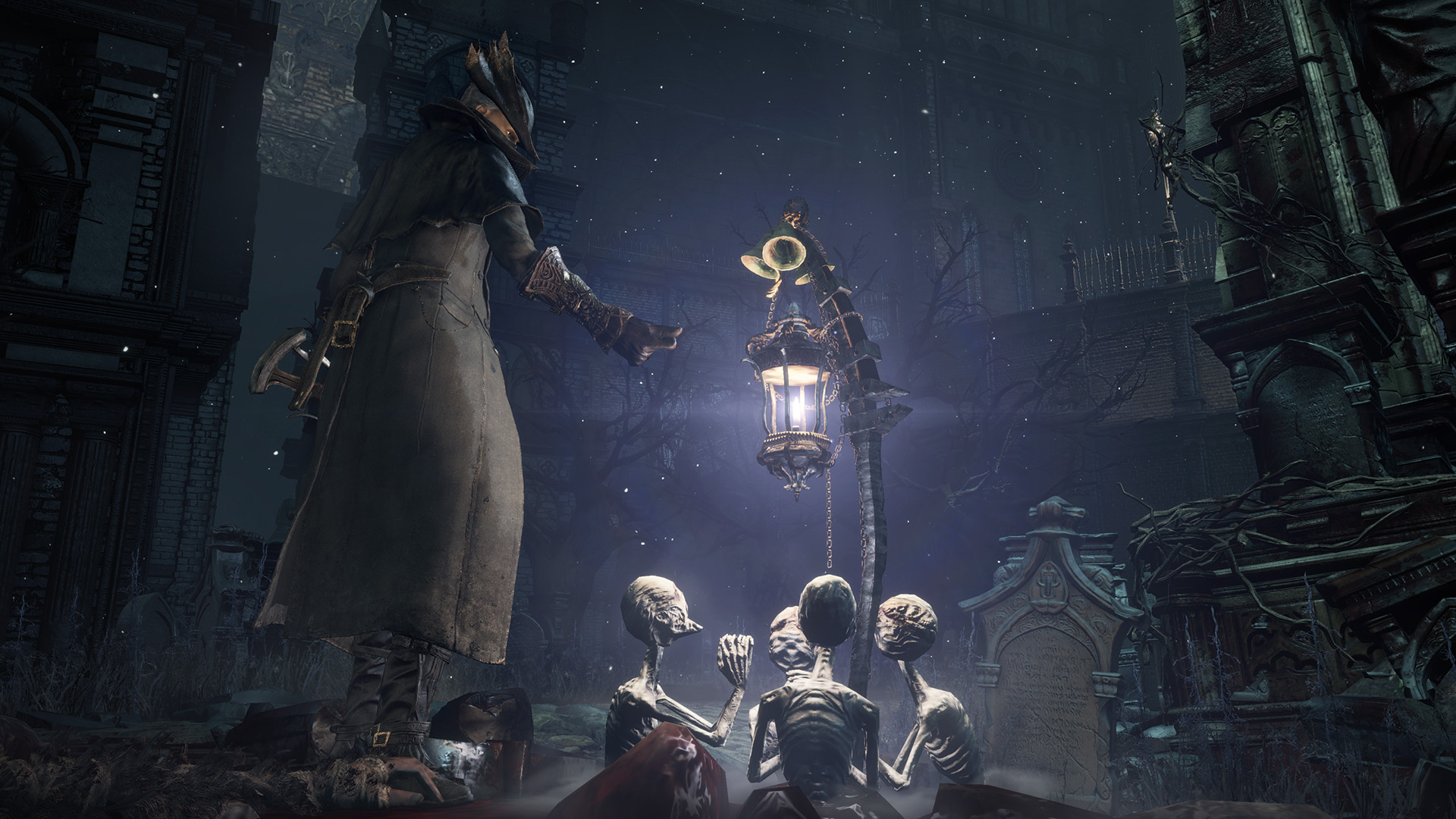
If you made it this far and haven’t played a game like this, you might be thinking, “Maybe this is is the one for me, and it’s time to see what all these folks are raving about.” I’d encourage you to do so, if only because I was in your situation about a year ago. It only took a few hours with Dark Souls before I was a convert, and I’ve been obsessed ever since. Is Bloodborne a good entry point? I don’t know. It’s a different kind of Souls game, yes, but still a Souls game, which means that it’s punishing and demanding. Bloodborne is what it is, and the Souls games have hardly ever compromised. They’re better for it.
Where does Bloodborne ultimately rank, then, among the Souls games? No idea. It’s a question for another day, when Bloodborne‘s had more time to sink in. Ask in a few weeks.
But more importantly, does that really matter? Not at all. Bloodborne is a fantastic game all its own, and requires no experience with anything else to enjoy and appreciate. It may be a riff on an existing idea, but it forges a standalone identity. It’s special, and there’s little else like it.
I could write about Bloodborne for another thousand words. I’ll certainly be doing that in the weeks and months ahead, as players around the world unlock more of its hidden secrets. Can I really transform into a beast? What other sects and covenants can I join? Does the game significantly change as players beat it over and over again? It’s uncommon to finish a game and still have so many burning questions about what’s left to be discovered, but that’s the kind of game Bloodborne is.
Phew. Now if you’ll excuse me, I’ve got a New Game Plus mode that’s calling my name.
patrick.klepek@kotaku.com or on Twitter at @patrickklepek.
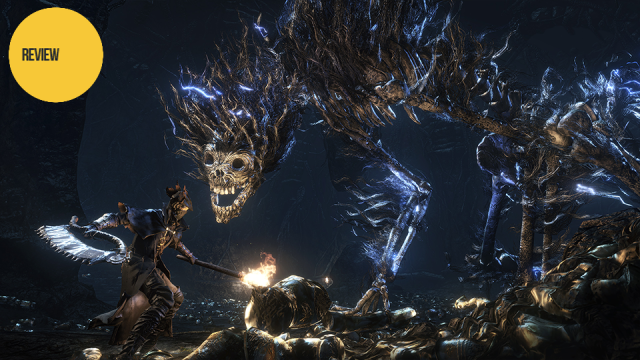
Comments
36 responses to “Bloodborne: The Kotaku Review”
My problem with Bloodborne, is that if you take a second and step back you immediately notice how little effort they put into the environment. Central Yharnam is the worst, the amount of bridges that just end in a flat un-rendered surface because nobody thought you would look up at said point in time, game could have used a little more time in QA.
They put a lot of effort into the environment. But the draw distance is pretty short to make up for it, so you’ll only notice if you go out of your way to look for them.
My real problem comes from Dark Souls 2. Because that game was so obvious with how they used impossible space that I actually noticed it in Bloodborne as well, even though they tried really hard to hide it.
I’m not so sure about this, given the size of the environment and the scale (and previous From titles) I don’t think it looks bad at all. Especially compared to other games with large game worlds like an open world game like Saints Row or a more similar ‘semi-open world’ game like Tomb Raider. The game also has a lot of physics, ragdol, breakable objects, cloth physics, and a lot of AI compared to those games.
In fact I’m surprised by how much detail they have put into the environment this time around, even if it’s polygonal detail (abundance of props) rather than more traditional details. (And their art style continues to shine through)
I mean, sure it’s not the Order, but its not bad by any stretch either, they just put their eggs and development time in other areas. And I’m glad about that.
What are you smoking? The environments are great.
Yeah, but if you look off into the distance you can tell the textures have de-loaded to compensate. For example, at the Cathedral Ward, go outside (where that cart with the big white guy across from the crow is), run up the stairs, go around to the area with those two giants. Walk to the fence and look down at the entrance you just came from. All the textures are reduced and that cart is missing.
That’s what you get on a console I guess 😉
Haven’t seen what you’re talkin bout but I do think that graphically it doesn’t really look ‘next gen’ – it’s the first essential PS4 game but quite honestly looks like like a PS3/360 game.
Again, it’s not the best looker sure, but considering the size of the world, it holds up against other games with large worlds IMO, but not the more linear games that Souls games are often compared to because of their semi-linear (but large) world design.
It looks worse than the Order or uncharted, but looks about on par with other open world games. All while sporting the physics etc that open world games normally sacrifice compared to games with more linear game worlds.
I’m just gonna copy and paste my last comment on the game.
I have one huge complaint about the game that isn’t really a spoiler.
Please developers, if you’re going to have New Game Plus, DO NOT THROW US INTO IT IMMEDIATELY. Give us the friggen option to do so. I just had the ‘ignore final boss’ ending because I misread the final choice and quitting out didn’t prevent the save.
Now I have to think about restarting all over again, or pushing through in New Game Plus.
Anyways, I’ll give some thoughts.
I think Bloodborne is an amazing game that brings back some of the Dark Souls elements that Dark Souls 2 was missing. The boss fights are amazing and each new area is different in approach and enemy types.
However, there are some things I was disappointed by. Armour stats are pointless when you can’t upgrade them and without Humanity to lose, losing some echoes is less of a punishment. Could have easily done that with Insight.
So I find it both way better than Dark Souls, but also a little be less.
In a situation like that, it may be worth yanking your last cloud save down from PSN. I’m not sure how often it syncs on PS4, but it probably won’t happen immediately.
I had to do the same thing in the first Dark Souls. I accidentally attacked a merchant, after which he would no longer sell anything to me. Obviously the game is constantly auto saving so I couldn’t just reload. But I got my cloud save down. It had synced the night before so I lost the hour or so that I’d played that night, but was better than having to start over again.
Uh, I’m kind of two days too late…
Hurry up and get here Bloodborne damn it… 🙁
Yeah, I’m on my second playthrough and I’ve already defeated the first 5 bosses.
O_O I’ma come and steal your copy in a moment…
You’re only saying that because my copy comes with an artbook, small resonating bell, quill with red ink and a notepad.
So does mine 😛 It’s just gotta get here from the competition first *sigh*
Where did you order your copy?! I saw a post by you a little further back that said you were waiting for it, is it coming by horse and cart or something? 😛
EDIT: Whoops, just read the rest of the comments. I figured they’d give it to you when you went to the event or something 😛
lol nah being sent out from sony or something, it’s all good, it’s just gonna take time, just getting jealous seeing all the Bloodborne articles lmao! Didn’t get to go to the event 🙁 Live in Brisbane, doing Uni and limited funds, wish I had of gone 🙁
Good luck, weresmurf. I won a vita in an smh comp, and it took Sony 8 months to send it to me, and it only got sent after tons of hassling them about it. I hope this doesn’t happen to you!
Not sure if it’s just me, but I find the bosses (so far, about 5 bosses in) to be relatively uninspired. At least they don’t gate progress as much as before. To me, the exploration and the non-boss combat is where its at in these games. In that regard I’m loving Bloodborne so far.
Also, I can see why @markserrels didn’t review this game – it would just be “I LOVE BLOODBORNE.”
It’s not just you, many of the bosses (and enemies for that matter) have the same look and attack patterns with slight variations. There are a few standouts but most are just dodge’n’spank (Since you can’t tank!) affairs.
Exactly. I’ve one shotted two bosses, and I haven’t ever finished Dark Souls or Demon Souls
Rom, Three Amigos, Moongoop, Fantasy japanese erotica manifest (ereb) and I suppose Gasci are the only bosses with any sort of flair.
As to the question of “why aren’t I out there trying to find a cure?” you sort of are (spoilers ahead)
You are lead to believe that the destruction of the child will prevent everyone turning to monsters at the dawn of the day after the night of the hunt, at the same time though you are acting out events in the mind of the old ones so whether or not there actually is something to cure is debatable, think of it like the matrixI’ve put in about 15 hours but I’ve become a bit bored. The gameplay gets repetitive and the bosses though different still boil down to the same mechanics to beat them.
I’ll start by saying I have NOT played this game. From what I have seen of it looks great but I was wondering this exact thing, does it get repetitive? I’ve watched many hours on YouTube etc. and really felt uninspired. I know there is a repetitive element to most games but when the general mechanics and general game play is the same for 50 hours…. I struggle to get through it.
Anyway it does like amazing, not paying out on it. If a game is long it better be long for a good reason and not padded out repetitive rubbish.
This game has infected my brain. I keep thinking about it when I’m not playing it. It is SOOOOO satisfying. There is such a great “vibe” to the world. I am LOVING IT!!!!
I’m a bit torn on the game atm. Area and boss name spoilers below.
At first I hated the games start area. It was tough i’d never played a souls game before and this game is unlike anything else i’ve played. You can’t pre preemptively dodge things because the reach is greater than your jump, quite often you have to dodge the attack in the inevitable “invincibility” window or with the trick like the Cleric Beasts left arm.
So until i realised this i was getting destroyed, that and relearning to not back up and heal after being struck. However after i killed the cleric beast I had already learned it and the game became much much easier. From there I went and 1 shot Farther Gascogne(sp?), 1shot the Blood Starved best. I then did Dark beast Paarl where I killed it on the 3rd attempt, then one shot Amelia, went and fought Amygdalla in the nightmare died instantly died instanly again then killed it only using a couple potions then strolled through the entire Hemwick area and killed the witches only getting hit once from the 2nd witch who snared me as she arrived on top of my character(in the boss fight i obviously got hit in the area). That entire hemwick area took me 30 minutes to complete.
My point is what happened to the difficulty? I had heard these types of games were punishing and at the start it was but now, besides optional bosses that you fight very early (paarl is the 9th and Amygdalla is like the 14th boss) the game has become a joke. I’m now level 50 and about to enter the forbidden woods and well i want it to get difficult again because the entire sense of accomplishment is gone.
Maybe my level is too high but that isn’t my fault, I have only farmed for blood stones and hp potions and have already wasted around 150k+ souls on items to slow my progress already Its why i have 99 Molotov potions and have sold none of my weapons yet bought every piece of armour and weapon. Maybe its because i haven’t lost any souls either outside the starting zone before you could level (I always make it back to my body if i die).
But my point is I haven’t farmed or power leveled in fact i’ve gone out of my way to gimp my level growth to make it harder (I have 30 insight too). So whatever my level is, is a natural result of my progression and I shouldn’t be over leveled anything at this point.
Is this game just not as difficult as the dark souls games or what? Because if it doesn’t get harder or I have to gimp myself to make it so then I don’t know if i should continue. I want that rush back where i’m fighting for my life, where I trade tit for tat and finally overcome my foe with 1 sliver of health left like my first encounter with an ai hunter when I fought him under a hail of minigun gun fire and my heart almost leapt out of my chest.
Look I’ll be honest by the sounds of it you’re just super pro.
I’m in love at the moment. Matyr Logarius has my number currently. Going to leave him and try the nightmare zone out tomorrow.
how is your logarius behaving? on my brothers file he stuck exclusively to his 3 swing melee combo and a high leap and slam down. On my file though he was casting flying skulls and explosions, summoning flying knives and doing end to end sweeps of the rooftop…as well as the other things. If he is reliably doing his melee combo, I recommend parrying him to beat him, he has a fairly forgiving parry window.
There’s a glitch where if you leave your PS4 on for too long or go into suspend mode, bosses lose most of their move sets. @mickymoo
You can legit beat him solo though. I did it at about level 70.
Roll to his side. When he goes to do his transformation (before the nova he releases) go behind him and do a visceral attack. This seems to prevent him from ignoring your visceral attacks, so you can keep doing them. But his attacks still go crazy – however they’re avoidable.
Bloodborne is the best! It feels like the sequel to Vagrant Story that I’ve always wanted.
The world feels more together and motivated than Dark Souls. I care and am interested in finding and talking to all the npc’s, and discovering the mystery to why everything is what it is. It’s also so goddam beautiful and stylised.
My character feels tougher and meaner jumping into danger, unlike my souls character who really did not want to be there and just hid behind his tower shield. I actually want to go back into the souls games and try a more aggressive build.
This is the first game in a long time (dues ex HR was the last) that I’m really hoping for some dlc so I can live in this world a bit more
To sum up all my thoughts on the game so far: it’s good, feels weighty and satisfying to play, but ultimately overhyped and really not as good as everyone thinks.
It’s the first really good ps4 exclusive, everyone will own it haha 😉
What a great review.